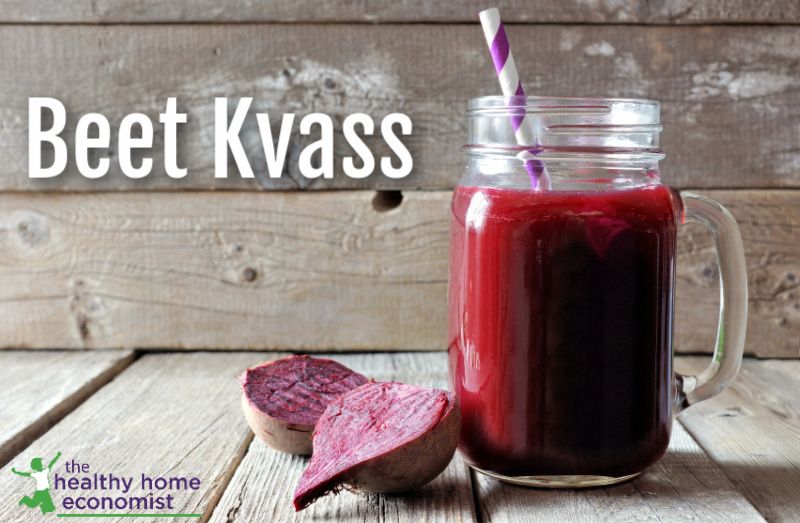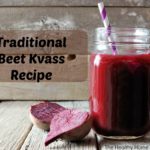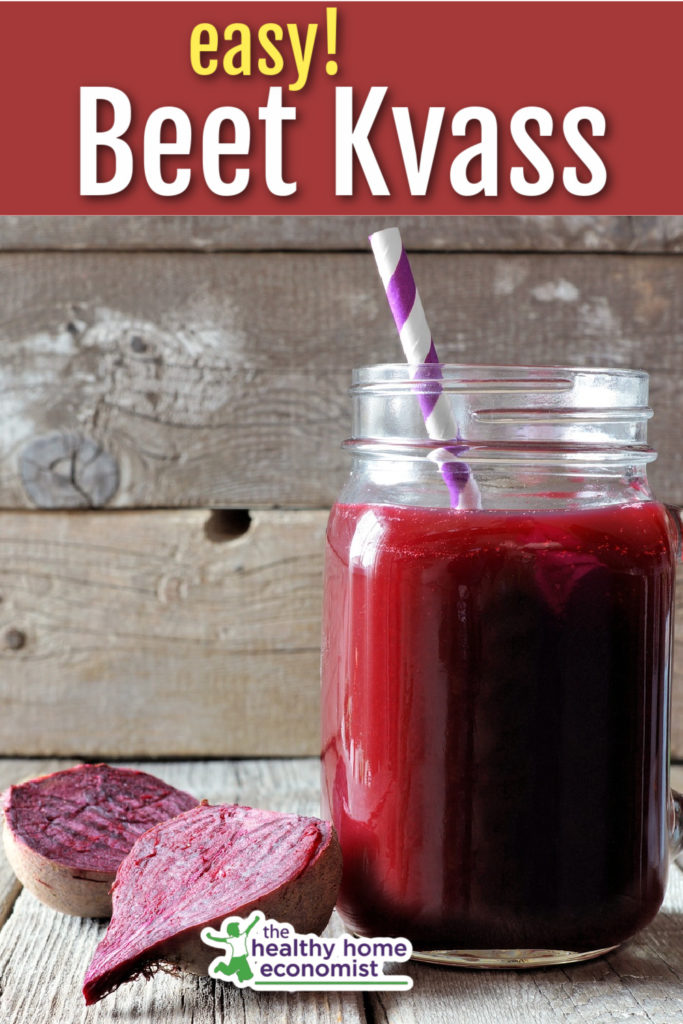Table of Contents[Hide][Show]
Beet kvass is potent, nutrient-rich tonic made by fermenting beets. It is essentially a DIY liquid multivitamin and more effective than taking brands from the store that contain synthetics!

One of the most nutritious and health-boosting fermented beverages you can make in your home is beet kvass. Beets are chock full of vitamins and minerals. Fermenting them supercharges nutrient levels even further and enhances absorption potential.
This ancestral tonic is extremely beneficial to those with any sort of digestive complaints.
In addition, beets are highly cleansing, so those with liver issues benefit from consuming beet kvass on a regular basis.
There isn’t another fermented drink that can improve health as rapidly in my personal experience.
Beet Kvass: DIY Liquid Multivitamin!
As a tonic, beet kvass is recommended first thing in the morning and after your evening meal.
Just 4 ounces or so is all you need to sip.
This highly nutritious superfood is far better than taking a multivitamin loaded with synthetic vitamins like folic acid.
I’m sipping a morning glass of beet kvass as I type this! What a great way to start the day and rev up your digestion each morning!
The recipe below was adapted from Nourishing Traditions Cookbook.
Most people make kvass with red beets. For a slightly sweeter and less earthy flavor, try making golden beet kvass.
If you find the results a bit salty, reduce the sea salt in the recipe to your liking.

Beet Kvass Recipe
Traditional beet kvass recipe that is an unbeatable morning and evening tonic for rapidly boosting health.
Ingredients
- 1-2 beets (1 large or 2 medium) preferably organic, tops removed
- filtered water
- 2 Tbl liquid whey
- 1/2 Tbl sea salt
Instructions
-
Wash beets thoroughly and slice into chunks no smaller than about 1/2 inch across. Feel free to peel the beets if desired; doing so reduces chances for mold on the ferment.
-
Put beet chunks into a clean, one-quart mason jar. Add whey, sea salt, and enough filtered water to fill all but 1 inch from the top of the jar. Stir and mix well. Close the lid and leave on the kitchen counter for 1-2 days. Try to keep it away from the fruit bowl to discourage the growth of mold.
-
Drink as desired and refrigerate once the fermentation period is complete. A 4 ounce glass morning and evening is recommended.
-
When an inch or so of beet kvass liquid is left in the jar, refill with more filtered water, stir, and close the lid again and leave on the counter for 2 days more. Refrigerate fresh batch of beet kvass and drink as desired.
-
When all the liquid is used up from the second batch, discard or compost the beets and start the process again.
Recipe Video
Recipe Notes
If the beet kvass is too salty for you, feel free to reduce the salt to 1/4 tablespoon for your next batch.
White fuzzy bubbles forming on the top of the liquid is normal and fine as the fermentation progresses.

More Fermented Drink Recipes to Enjoy
How to Make Fermented Lemonade
Orangina Recipe (Fermented Orange Juice)
How to Make Kombucha








Can a person use less salt? If I strain my clabbered milk is that liquid considered whey? Would using an airlock cover make a difference with preventing mold? I saw some neat looking jars for fermenting at pickl-it.com but the price was way more than we could afford for our large family. I did a search for using mason jars and found this site: http://gnowfglins.com/2010/07/16/diy-airlock-fruit-and-veggie-ferments/
I love your site Sarah! I wish the videos were downloadable though. I have dial-up at home and it takes forever. Being able to download them in town with high-speed and then watch them at home would be great.
Thanks for sharing your knowledge.
Cindy
I am new to all this fermenting stuff and want to know what is the difference nutrition wise between fermented shredded beets and beet kvas. I just tried making fermented beet, after two day I noticed a mold growing on top. I skimmed it off (hate throwing things out) and let it stay a little longer to see if the mold would come back; it didn’t. So I figured, they are good to go. I put them in the fringe to cool off. Just want to make sure they are safe to eat.
Can I use just salt or extra salt instead of whey? I used extra salt and it was VERY salty. Second round was better. Not sure if I’m getting any benefit since I didn’t use the whey. I know in other recipes if we don’t use whey, we can use more salt (good salt). If I use whey, does it have to be from fresh raw milk or can I use raw milk that’s been frozen first?
I have made two good batches of beet kvass, but my third batch grew mold. The first batch I used some some whey that I strained from store bought yougurt. The second batch was just adding more water to the first. The third batch i used fresh beets, but i bought some local non-homoginized yougurt. I got alot more whey from this,(about 1 cup) and used it all in this batch. I also let it go for 4 days. Do you think it was the whey I used, or the amount, or the time that caused the mold to grow on top. Also the beet chunks were floating as well. Any input would be great. Oh!, i threw out my moldy batch, could I have skimmed it and still used it?
Thanks,
Jason
I skim and use mine.
Thanks for the quick response. Too bad i threw it out. I just started a new batch today. Its only been a day and a half without it and my blood pressure has already gone up a bit. I will only fermenting this for 24hrs and try to ferment the next batch for 48. Thanks for you awesome site.
Hi Sarah,
I am making both vegetarian Kimchi and fermented sauerkraut using whey. I usually save liquid portions of both products after they have fermented. Can I use sauerkraut/Kimchi liquid as a starter for beet kvass?
Also You said that you use 1/8th of the cup of whey. That is one ounce, i.e. 29 grams. I think you had much more than that in your jar. Thanks, Safet
Hi Sarah,
Not sure if you are using cheese or kefir whey or does it matter?
Thanks for the video.
Am about to make my first batch of kvass – someone recommended it to me as I am pregnant with baby 4 (baby 3 will be 1 in December) and this pregnancy I’m having morning sickness and other digestive issues for the first time.
Might someone describe how it ought to look when it’s ready to go from the counter to the fridge? How do I know it’s getting “close” and not to let it sit out too much longer?
Thanks so much!
Pauline
Sarah, I break out in hives with whey found in processed foods. Is the whey you are using the same thing? Is there something else I could use to replace whey? I really want to make this for me and my mom who right now UC hospital with liver cancer. She has cirrhosis of the live from diabetes type 2. Thanks, Susan
So I found a rather unconventional way to use the last dregs of beets kvass. I was looking at how bright fuschia it was, and decided to dip my finger tip in it and rub it on my cheek like a cheek stain. Totally worked! It gave just the slightest hint of color to my cheeks and looks like a perfectly natural rosy glow. My husband thinks I’m completely nutso, but I’m excited at having a new natural make-up product! I poured the rest into an empty glass spice container and stuck it back in the fridge. I’m sure since it’s fermented it will keep for a long time.
I have seen recipes for fruit kvass with honey instead of salt in them, I was wondering if you could combine apples and beets to make kvass just a little bit sweeter without making the really sweet kind?